Even before we heard about the high water, we were alerted that we had beaver damage on our property.
Our trees have been wrapped in hardware cloth for almost two decades. Back in 2000, we arrived in early May to find that beavers had taken down 14 trees sometime during the month of April. They seemed to prefer trees with trunks 2 to 6 inches in diameter. The largest was a maple with 12-inch diameter trunk, that had towered over our big cottage. Nothing remained, but the denuded trunk. The beavers had stripped away all the branches and the bark. The smaller trees were entirely gone with only the telltale, beaver-gnawed spike remaining. At least they cleaned up their workspace.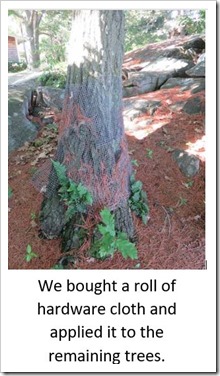
I noticed last year that many of the trees had expanded and that some of the hardware cloth had popped off. I guess the beavers noticed too.
There might have been as many as 200 million beavers on the continent before Columbus arrived. Beavers were a huge part of the economy back in colonial days, which is the reason that you can find the image of beavers on the coat of arms for both Ontario and New York. It’s the national animal in Canada and the state mammal in New York. They were hunted to near extinction.
When Uncle Otis built the first of our two cottages in 1881, there were no beavers in the area. A “Thousand Island Sun” article in 1958 reported that there were now three beaver colonies in the Thousand Island region and indicated that the beaver population was on the rebound. That was nearly 60 years ago. Their numbers have increased dramatically since then.
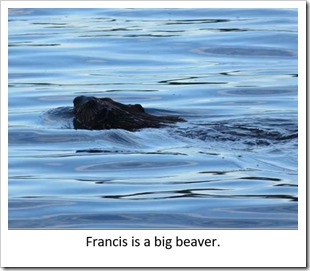 In May, our daughter was sloshing out of the boathouse, stopped and pointed to something in the water between our boathouse and our neighbor’s boathouse and asked, “What’s that?”
In May, our daughter was sloshing out of the boathouse, stopped and pointed to something in the water between our boathouse and our neighbor’s boathouse and asked, “What’s that?”
I couldn’t see what she was pointing to, but heard a loud splash and knew it was a beaver slap. Beavers use their broad tails to slap the water, perhaps to scare away people or let other beavers know that “I’m here and this is how big I am.”
I saw the beaver a week later. I’d heard from other people on the island that it was a big beaver and they were right. I’ve never seen a beaver that big before.
This was just the first of many sightings. From the Internet, I learned it’s hard to distinguish between male and female beavers. So our neighbor named it Francis as that name can be either male or female. They’d seen a lot of Francis in June, especially in the evenings. Francis was spending a lot of time under their floating dock.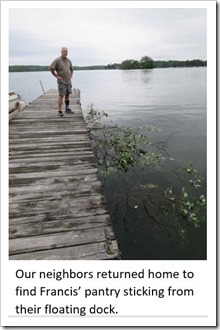
“Just one beaver? Are there others?” I asked. They’d only seen the one lone beaver.
That was odd. I thought beavers were social animals that usually lived in colonies. The Internet confirmed that, yes, beavers usually lived in colonies. I also discovered two other beaver facts: beavers never really stop growing, so the bigger they are, the older they are and they are monogamous.
So I came up with the scenario that Francis was an older beaver who had lost its mate and was striking out to live on its own for a while. I could hear Francis thinking, “I’m not ready to start that whole dating scene yet. I’ll just live on my own for a while. Hey, this looks like a starter kit for the lone beaver. It’s an instant roof over my head.”
(Can you tell I’m a fiction writer at heart?)
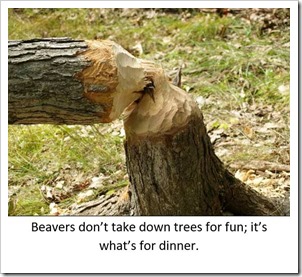 Our neighbors left for a few days and while they were gone Francis was busy. When they returned, their dock was bristling with branches. Francis was stocking its pantry. Beavers eat bark and early in the season they like evergreen twigs. I popped over to see what was on Francis’ menu for the coming week. There was birch, pine, oak, ash and---was that cedar? Was Francis eating our cedar trees? I pulled on my boots, rushed back to our point and sloshed down to the shade garden which is now under water and saw that Francis had been taking branches off our cedar trees.
Our neighbors left for a few days and while they were gone Francis was busy. When they returned, their dock was bristling with branches. Francis was stocking its pantry. Beavers eat bark and early in the season they like evergreen twigs. I popped over to see what was on Francis’ menu for the coming week. There was birch, pine, oak, ash and---was that cedar? Was Francis eating our cedar trees? I pulled on my boots, rushed back to our point and sloshed down to the shade garden which is now under water and saw that Francis had been taking branches off our cedar trees.
My mother-in-law had planted and nurtured this row of cedar trees for two decades. The cedars provided a privacy screen from the public path and the shade for our shade garden. We’d already lost the shade tree that kept our big cottage cool on hot summer days. I didn’t want to lose the cedar trees. This was war. But a war I wasn’t sure how to fight.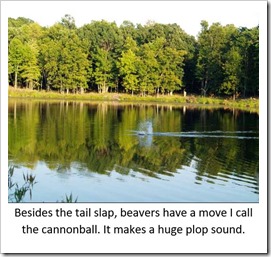
How does one get rid of beavers? There was killing them, which wasn’t an option for me personally. There were traps, but I’d read beavers are very territorial and once they had found a place to live were very persistent and kept coming back.
Then I happened upon a chatroom post about beavers living under floating docks. One guy said that he’d read that beavers didn’t like strong smells so his wife bought some Irish Spring Soap, grated it, put it in a mesh bag, hung it under the dock and that got rid of the beaver. Another guy simply peed on the dock and that got rid of the beaver, too. I passed this information onto our neighbors, who didn’t have any Irish Spring so they went for Option 2.
After collecting a jar of urine, they went down to the dock after they’d seen Francis come home for the evening. First, they stomped and jumped hoping that would coax Francis out. When that didn’t work they began sprinkling urine through the slats on the dock and ZOOM--- Francis shot out of there. Francis did a swim-by the next evening, but as they had dosed the dock a second time, Francis didn’t find its new digs nice any more. Francis was officially evicted.
 We still saw Francis swimming around either early in the morning or late in the evening. Another islander saw him on the path. I didn’t like the fact that Francis was still hanging around. And I didn’t like that cedar branches continued to disappear from our cedar trees.
We still saw Francis swimming around either early in the morning or late in the evening. Another islander saw him on the path. I didn’t like the fact that Francis was still hanging around. And I didn’t like that cedar branches continued to disappear from our cedar trees.
I went back to the Internet trying to find more info about solitary beavers. Wouldn’t Francis be happier living among other beavers than with people on Grenell?
I found a website about solitary beavers in Europe. They have a special name for solitary beavers there: terriers. The website said terriers have a scruffy appearance. They are rogue beavers forced from their colonies because of anti-social behavior. Francis didn’t look scruffy to me. I much preferred my grieving beaver scenario to the rogue, miscreant scenario.
I emailed Bob Arnebeck who lives year-round in Thousand Island Park and has amazing pictures and videos of beavers on Wellesley Island on his website bobarnebeck.com. I asked Bob if he knew anything about solitary beavers. Bob replied that yes, beavers are sometimes solitary. In fact, there had been a solitary beaver that lived in the cove near his cottage the past several years, but he hadn’t seen it this season. This beaver liked to eat acorns that dropped near his dock.
Bob’s cottage isn’t that far away from us. We are at the foot of Grenell and he is at the head of Wellesley. Could this be Francis? Perhaps the high water forced Francis from its home. Is Francis, like us, just adjusting to unusually high water? When the water goes down, will Francis go back to his home on Wellesley?
Then I heard Francis was as living under our neighbors’ cottage on the upriver side, a short beaver swim from my beloved cedars. And we heard Francis, the huge beaver, had a younger, smaller friend.
But I think Francis might have been evicted from our neighbors’ cottage because he’s been hanging around our workshop/laundry room area. Francis might have decided to bunk with us awhile. I don’t mind providing a roof over Francis’ head for a night or two. Room is okay, but room and board are out of the question. I don’t want to feed a hungry beaver for the rest of the summer. Perhaps we need to get another roll of hardware cloth and a bag of acorns.
By Lynn E. McElfresh
Lynn McElfresh has done it again – found a topic that is of interest to those of us who have been “fighting” Francis and his/her relatives and friends for many years. In 1989, we had some very busy beavers… they took down 89 trees on Sagastaweka Island. I am afraid I then said that the only good beaver was on my back! So Lynn, thanks again for your amazing work. We appreciate it. This marks you 103 article. You can see all of Lynn’s articles here. (We celebrated her #80 in July, 2015!)